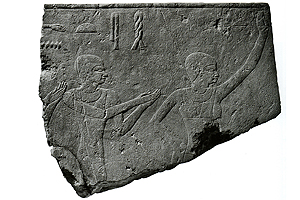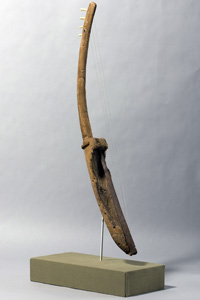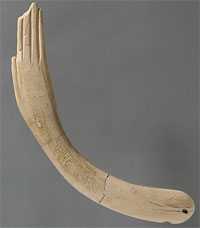Exhibition recreates life of temple singer
By William Harmsw-harms@uchicago.edu
News Office
|
|||||||||||
Visitors will come face to face with a newly drawn image of an ancient Egyptian singer-priestess named Meresamun in a new exhibition at the Oriental Institute Museum.
From the instruments she played to details about her health, the exhibition, “The Life of Meresamun: A Temple Singer in Ancient Egypt,” will provide a personal look into Meresamun’s life.
Details about her health, as revealed in CT scans using the latest equipment, help tell her life story. “In a virtual way, people will be able to meet this remarkable woman and, through her eyes, learn what it was like to live in Egypt 2,800 years ago,” said Emily Teeter, Research Associate at the Oriental Institute and curator of the exhibition. “We will be able to ‘recreate’ the life of an Egyptian in a way no one has attempted before.”
The exhibition will be on display at the Oriental Institute Museum from Tuesday, Feb. 10 through Sunday, Dec. 6. The centerpiece of the show is a brightly decorated coffin that contains the body of a woman who lived in Thebes (modern Luxor) in southern Egypt about 800 B.C.
A brief inscription on the coffin records her name and says that she served as a singer in the Interior of the Temple of Amun. Such singers were elite priestess-musicians who accompanied the High Priest as he performed rituals before the god Amun.
In preparation for the new show, a group of faculty, staff and graduate students in Egyptology teamed with Michael Vannier, Professor in Radiology, to undertake a multidisciplinary approach to reconstructing Meresamun’s life.
“A goal of the study and of the exhibit was to make the past less abstract by recreating the life of a specific individual. It is amazing how much information about Meresamun’s life can be mined from scenes on tomb and temple walls and from ancient texts, and how familiar so many aspects of her life seem to us today,” Teeter said.
In 1991, Medical Center radiologists examined the mummy and coffin with CT scans and then again in summer 2008. The mummy had a “call back” last September after the Medical Center installed the newest generation CT scanner. Meresamun was the first subject in Chicago to be studied with the Philips Healthcare Brilliance iCT (“Intelligent CT”) 256-channel scanner, which gave dramatically detailed views.
A video display will allow visitors to view features of Meresamun’s physical state and perform a “virtual unwrapping” of the mummy, enabling them to see how it was prepared. Advanced digital techniques have made it possible to recreate Meresamun’s appearance.
She was tall by ancient standards—5-and-a-half feet—her features were regular with wide-spaced eyes, and she had an overbite. “Meresamun was, until the time of her death at about 30, a very healthy woman,” Vannier said. “The lack of arrest lines on her bones indicates good nutrition through her lifetime and her well-mineralized bones suggest that she lived an active lifestyle.”
Oriental Institute Director Gil Stein pointed out that “interdisciplinary studies, in this case the collaboration of new research in Egyptology and the most advanced imaging techniques, are a hallmark of the University.”
The exhibition includes 71 artifacts ranging from musical instruments, written documents and pottery, to stelae, jewelry and objects similar to those that Meresamun would have had or used inside and outside the temple. A selection of ritual objects, including a sistrum (a type of rattle), an ivory clapper and a harp help to illustrate the temple singer’s duties.
Other objects document ritual activities that she would have participated in, such as the consultation of divine oracles and officiating in animal cults. Other objects, such as a selection of necklaces, hairstyling tools and a hand mirror decorated with gold leaf, reflect her personal life.
Objects on display attest to the remarkable legal and social rights women held in ancient Egypt. A papyrus, for instance, is inscribed with an annuity contract. It states that in exchange for 30 pieces of silver that a woman gave to her husband, he, in turn, was obligated to supply her with a stated amount of silver and grain each year.
Geoff Emberling, the Director of the Oriental Institute Museum, said, “Our collections have seemingly unlimited research value. It is remarkable how the mummy of Meresamun, which has been on exhibit for nearly 80 years, is now the focus of research that is providing new perspectives on life more than 2,800 years ago.”
 A relief of women dancing, singing and clapping to the beat. ca. 2504 B.C. |
A public symposium also is scheduled from 9:30 a.m. to 4 p.m., Saturday, Feb. 21, at the Oriental Institute. Titled “A Mummy Comes to Life: Science and Art Resurrect an Ancient Egyptian Priestess,” speakers will include curator Teeter, Janet Johnson, the Morton D. Hull Distinguished Service Professor of Egyptology, who co-edited the exhibition catalogue; Hratch Papazian, Lecturer in Egyptology; and Vannier, who is editor of the International Journal of Computer Aided Radiology and Surgery.
For more information, call (773) 702-9507 or visit http://www.oi.uchicago.edu.
To become a friend of Meresamun, visit Facebook at http://www.facebook.com/ and search for Mummy Meresamun.
Related links:
http://www.uchicago.edu/features/20080804_mummy.shtml
http://oi.uchicago.edu/museum/special/meresamun/
![[Chronicle]](/images/sidebar_header_oct06.gif)



